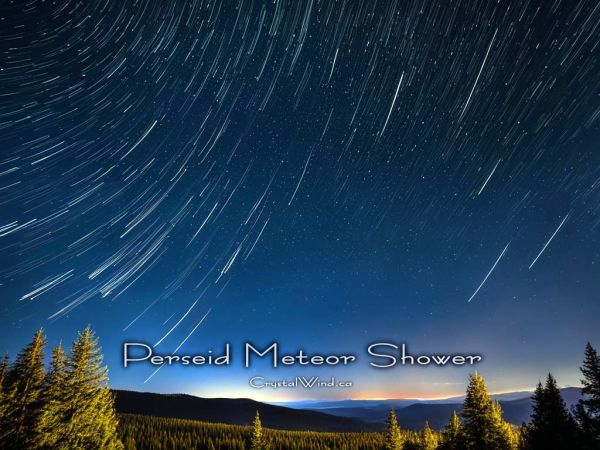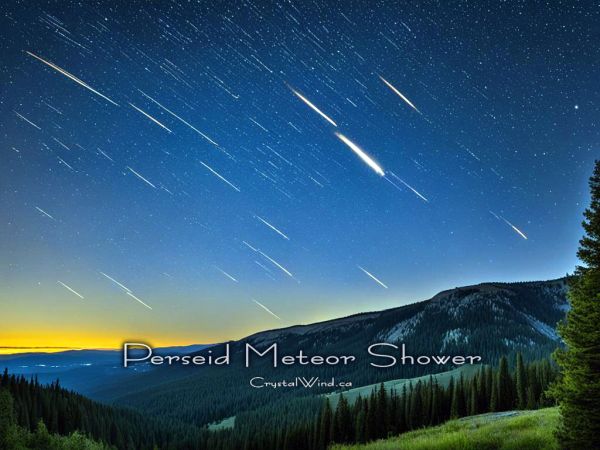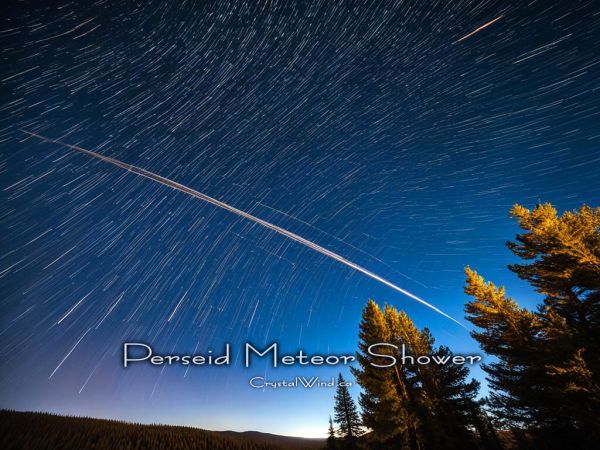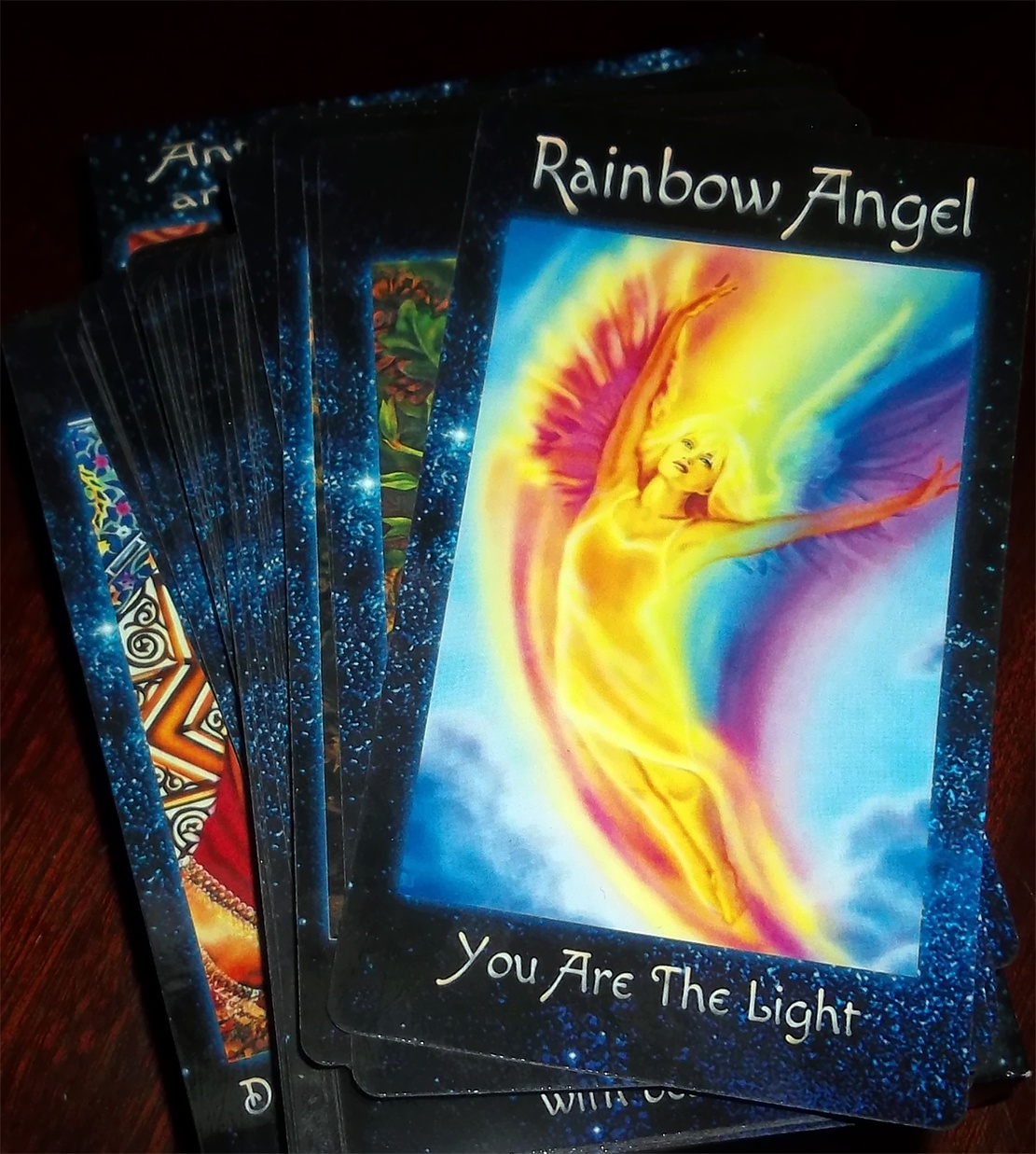Perseid Meteor Shower 2024: Stargazing Spectacle
- Details
- Written by And-El
- Views: 2522

The 2024 Perseid meteor shower is a must-see event in the sky. It's known for its bright and colorful trails.
The best time to see it is on the mornings of August 11-13, in the Northern Hemisphere.
Under perfect conditions, you might see up to 100 meteors per hour. This happens when Earth goes through the debris left by the comet 109P/Swift-Tuttle.
People have been watching the Perseid meteor shower for centuries, even in ancient China. It's a top event for anyone who loves stargazing. As it gets closer, people are excited to see the beautiful shooting stars in the night sky.
What is the Perseid Meteor Shower?
The Perseid meteor shower is a stunning event that happens every year. It happens when Earth goes through the trail left by the comet 109P/Swift-Tuttle. Tiny particles from the comet burn up in Earth's atmosphere, creating shooting stars in the sky.
This shower is famous for its colorful and long-lasting meteor trails. It's a favorite among those who love to watch the stars.
Parent Comet: 109P/Swift-Tuttle
The comet 109P/Swift-Tuttle is the parent of the Perseid meteor shower. It's a big, icy comet that takes about 133 years to go around the Sun. As it moves, it leaves behind a trail of debris.
When Earth goes through this trail, the Perseids appear in the sky. They give us a beautiful show of shooting stars.
|
Perseid Meteor Shower Statistics |
Data |
|
Predicted peak |
August 12, 2024, at 14:00 UTC |
|
Moon phase during peak |
First quarter moon with 50% illumination |
|
Duration of the shower |
July 14 to September 1 |
|
Expected meteors at peak |
90 meteors per hour or more under a dark sky |
|
Parent comet |
Comet 109P/Swift-Tuttle |
|
Radiant point |
Constellation Perseus near the Double Cluster |
The Perseid meteor shower is a breathtaking event that draws in stargazers from all over. Learning about its origins helps us appreciate the beauty of our universe.
Peak Viewing Dates and Times
The Perseid meteor shower will hit its peak on August 11-13, 2024. These three days are the best time to see many meteors in the sky.
August 11-13, 2024: The Prime Window
The Perseid meteor shower peaks on August 11, 12, and 13, 2024. During these days, you'll see the most meteors. The radiant point will be at its highest just before dawn.
Best Hours for Meteor Watching
The best time to watch the Perseid meteor shower is from midnight to dawn. The radiant point appears in the northeastern sky and reaches its highest point just before sunrise. You'll see the most meteors in the hours before dawn.
Under the best conditions, you might see up to 100 meteors per hour during the peak. The Perseids are known for their bright, fast streaks. These streaks often leave trails that glow in the sky.
"The Perseids are widely regarded as one of the most spectacular meteor showers of the year, offering a dazzling display of celestial fireworks that captivates stargazers around the world."
To get the most out of it, go under clear skies, away from city lights. Let your eyes get used to the dark for at least 30 minutes. With the right conditions, the Perseid meteor shower will be an amazing sight in 2024.
Perseid Meteor Shower 2024: Radiant Point
The Perseid meteor shower is known for its stunning display in the sky. To fully enjoy it, knowing the radiant point is crucial. The Perseids appear to come from the constellation Perseus. This spot in the sky, where meteors seem to meet, is called the radiant.
The radiant starts in the northeastern sky around 11 PM. It reaches its peak just before dawn. Looking towards the radiant increases your chances of seeing more Perseid meteors. Meteors appear to come from this specific point in the sky.
|
Radiant Point Statistics |
Details |
|
Radiant Constellation |
Perseus |
|
Radiant Right Ascension |
03h10m |
|
Radiant Declination |
57°N |
|
Radiant Altitude |
Approximately 60° above the horizon an hour before sunrise |
Knowing where the Perseid radiant is key for stargazers. It helps you see more of the amazing Perseid meteor shower in 2024. By looking towards the radiant, you'll catch more of the beautiful sights this event offers.
How to Maximize Your Perseid Viewing Experience
To enjoy the Perseid meteor shower in 2024, find the best spot and prepare your eyes. By using a few simple tips, you can make your viewing experience better. This way, you can see the stars in all their beauty.
Finding a Dark Sky Location
The Perseid meteor shower looks best from places with little light pollution. Move away from city lights and bright outdoor lights to a dark spot. This could be a remote countryside, a national park, or a quiet backyard in the countryside. The aim is to find a place where the night sky is as dark as possible. This lets you see more meteors and details in the sky.
Allowing Time for Eye Adjustment
After picking your perfect spot, let your eyes adjust for 20 minutes. This process, called dark adaptation, helps improve your night vision. Don't look at your phone or any bright lights during this time. They can mess up your eyes' adjustment and make it harder to see the meteors. Being patient and prepared is important for a great Perseid viewing.
By following these easy steps, you're on your way to seeing the amazing Perseid meteor shower. Remember to relax, enjoy the night sky, and let your eyes get used to the darkness. This will give you the best viewing experience.
Predicted Meteor Rates and Fireballs
As the Perseid meteor shower peaks in August 2024, stargazers can look forward to a stunning show. With a dark sky and little moonlight, up to 100 meteors might flash across the sky each hour. But a more likely count is 50-60 meteors per hour, still a great sight for those who love meteor showers.
The Perseids are famous for their bright, long-lasting fireballs. These meteors can shine as brightly as the planet Venus. They happen when big pieces of a comet burn up in our atmosphere.
|
Meteor Shower |
Peak Date |
Peak Hourly Rate |
Parent Body |
|
Perseids |
August 11-12, 2024 |
50-100 meteors |
Comet Swift-Tuttle |
|
Orionids |
October 20-21, 2024 |
20-25 meteors |
Comet Halley |
|
Southern Taurids |
November 4-5, 2024 |
5-10 meteors |
Comet 2P/Encke |
|
Leonid’s |
November 17-18, 2024 |
10-20 meteors |
Comet Tempel-Tuttle |
|
Geminids |
December 13-14, 2024 |
100-120 meteors |
Asteroid 3200 Phaethon |
|
Ursids |
December 21-22, 2024 |
5-10 meteors |
Comet 8P/Tuttle |
The Perseid meteor shower is known for its reliability and consistent performance. It's a favorite among stargazers and photographers. With the right conditions and patience, you can see the amazing Perseid fireballs and meteor shower rates the Perseids are famous for.
Perseid Meteor Shower 2024: Moonlight and Visibility
In August 2024, the Perseid meteor shower will peak. But, the waxing moon will make it harder to see the fainter meteors. The moon will be about 50% bright on August 11-12 and 61% on August 12-13.
Still, the best time to watch is after midnight. This is when the moon sets and the Perseid shower is at its peak. Try to see it in the pre-dawn hours for the best view.
Impact of the Waxing Moon
The Perseid meteor shower moonlight and moon phase impact will affect the 2024 event. The waxing moon might hide some meteors. But, the Perseids are known for their bright, colorful fireballs. These will still be visible in the moonlight.
|
Date |
Moon Phase |
Moonlight Impact |
|
August 11-12, 2024 |
50% Illuminated |
Moderate |
|
August 12-13, 2024 |
61% Illuminated |
Significant |
Even with the moon around, the Perseid meteor shower 2024 will be amazing. By watching in the pre-dawn hours, skywatchers can see the meteor shower moonlight at its best.

Capturing Perseid Meteors: Astrophotography Tips
Photographing the Perseid meteor shower is both rewarding and challenging for astrophotographers. Use a wide-angle lens, a sturdy tripod, and set your camera for 10-30 seconds. Include interesting foregrounds, like landscapes or silhouettes, to add depth to your shots.
Be patient and keep trying, as meteor trails can be hard to catch. Try different settings and compositions to see what works best for you. An astronomy app like PhotoPills can help plan your night for night sky photography of the meteor shower.
The best time to see shooting stars is in the pre-dawn hours during the peak. This is expected on August 11, 12, and 13, 2024. The Perseids are known for their brightness, speed, and long-lasting trails of light and color.
To avoid star trails in your photos, use the 500 Rule. This means the longest shutter time is 500 divided by your lens's focal length in millimeters. It's also key to find a dark spot away from city lights for the best views and photos.
|
Astrophotography Tip |
Recommended Setting |
|
Lens |
Wide-angle lens |
|
Exposure Time |
10-30 seconds |
|
Tripod |
Sturdy and stable |
|
Composition |
Include foreground elements |
|
Timing |
Pre-dawn hours during peak |
|
Shutter Speed |
Follow the 500 Rule |
|
Location |
Dark sky location |
Follow these astrophotography tips to boost your chances of getting amazing photos of the 2024 Perseid meteor shower. Show the beauty of the night sky.
Perseid Meteor Shower History and Lore
The Perseid meteor shower has amazed people for centuries. Its history comes from ancient Greek myths and space legends. In Greek stories, the Perseids are linked to Perseus, Zeus's son. They say the shower honors Zeus's visit to Danaë, Perseus's mom, in a golden shower.
Some old cultures thought the Perseids were the tears of Athena, mourning Achilles's death. The Perseids are seen as a great sky event. They still amaze and inspire people all over the world every year.
Ancient Greek Mythology and Celestial Legends
Since ancient times, the Perseid meteor shower has been linked to Greek myths. It's said to remember Zeus's visit to Danaë, Perseus's mom, in gold. This story of Perseus has stayed with us, making the meteor shower a Greek myth celebration.
Some old cultures thought the Perseids were Athena's tears, mourning Achilles's death. This beautiful idea adds to the shower's deep space stories.
"The Perseids have long been celebrated as a spectacular celestial event, and their annual appearance continues to captivate and inspire stargazers around the world."
The Perseid meteor shower's history and myths have lasted for centuries. They show our deep interest in the stars. When we watch the shooting stars each summer, we join a tradition from the beginning of human history. It's a reminder of our spot in the universe's big story.
Spotting Sporadic Meteors During the Perseids
During mid-August, the Perseid meteor shower lights up the night sky. But, you might also see random meteors not linked to the shower. These are called sporadic meteors. They can come from anywhere in the sky, unlike the shower meteors.
Knowing where the Perseid radiant is in the constellation Perseus helps you tell shower meteors from sporadic ones. This skill makes watching the meteors more interesting. It helps you appreciate the beauty of the Perseid shower even more.
While the Perseids are the main event, spotting sporadic meteors can make it even more thrilling. These sudden flashes of light can happen anytime. They bring surprise and wonder to your stargazing.
|
Meteor Shower |
Peak Dates |
Hourly Meteor Rate |
Radiant |
|
Perseid |
August 12-13 |
100 |
Perseus |
|
Orionid |
October 21-22 |
20 |
Orion |
|
Leonid |
November 18 |
10-15 |
Leo |
|
Geminid |
December 14-15 |
150 |
Gemini |
Keep an open mind and watch the sky during the Perseid shower. You might see the beauty of sporadic meteors as they move across the sky. This adds to the magic of the celestial show.

Expert Insights and Astronomical Perspectives
As the Perseid meteor shower of 2024 gets closer, experts and enthusiasts share their insights. Pete Lawrence, an astronomer, suggests finding a dark spot and letting your eyes adjust for better viewing. Deborah Byrd, from EarthSky.org, calls the Perseids the favorite meteor shower in the Northern Hemisphere. This is because of their bright trails and timing in summer.
The Perseids last from late July to mid-August. They happen when Earth goes through debris from comet 109P/Swift-Tuttle. Meteors form when small particles burn up in our atmosphere at 60 km/s.
The Global Meteor Network tracks meteors with cameras in over 40 countries. They say the Perseids peak will be on Sunday, Aug. 11, into Monday, Aug. 12. During this time, you might see dozens of meteors per hour, if it's dark and not too close to dawn.
"The Perseids can be best viewed from mid-northern latitudes. The 2024 annual Perseid meteor shower will be optimal as the moon will be 50% illuminated and will set at midnight."
Meteoroids from comets and asteroids tell us about the solar system's beginnings. Deborah Byrd says the Perseid shower lets us see these cosmic wonders up close.
Perseid Meteor Shower 2024
Stargazers, mark your calendars! The 2024 Perseid meteor shower is coming, peaking on August 11-13. It's a must-see for skywatchers in the Northern Hemisphere.
This shower happens when debris from comet 109P/Swift-Tuttle hits Earth's atmosphere. It takes 133 years for the comet to orbit the sun. Last time it was seen in 1992. Under the best conditions, you might see up to 100 meteors per hour.
The radiant, or where the meteors seem to start, is low in the north at night. It moves higher towards the northeast as the night goes on. In 2024, the moon will be half-lit and set by midnight, making the sky darker for better viewing.
To enjoy the shower, watch the sky for at least an hour. This helps even out the number of meteors you see. Also, spotting the faintest star you can see helps scientists understand how well you can see meteors.
The International Meteor Organization works with the AMS to collect data on meteors. By sharing what you see, you help scientists learn more about these amazing events.
Whether you're an expert or just enjoy looking at the stars, the 2024 Perseid meteor shower is a must-see. So, grab a blanket, find a dark spot, and get ready for the Perseid meteor shower 2024!
Meteor Shower Photography: Showcasing Cosmic Wonders
Capturing the beauty of the Perseid meteor shower is exciting for photographers. Using wide-angle lenses and long exposure times helps capture the light trails in the sky. Adding interesting scenes in the foreground makes the photos more engaging.
The Perseid meteor shower is famous for its bright and long-lasting trails. This makes it a favorite for photographers who love the night sky. Fireballs, which are bright and colorful explosions, are a key part of the shower. They are perfect for capturing the beauty of the sky.
When Earth goes through the Swift-Tuttle comet's debris, the Perseid meteor shower happens. It's a great chance for photographers to show the beauty of the night sky. With skill and creativity, photographers can make photos that amaze and inspire others.
Meteor showers are named after the constellation from which they appear to originate. In this case, it's the constellation Perseus, which is located at latitudes between +90 degrees and -35 degrees and is named after the hero from mythology who killed Medusa.
How to Wish upon a Shooting Star?
1. Close you eyes and Relax
2. Meditate on things you Wish to have.
3. Now focus to things that your heart desire the most. Things that set you on Fire!
4. Narrow down your wishes to only one, your most important wish.
5. Stay focused on your Wish. Live it as it already happened!
6. Open your eyes and wait for the Shooting star. Once you see it Re-Live it one more time quickly!
7. Thank the Divine Forces that helped you!
The original article is copyrighted by the author listed above. Posted on CrystalWind.ca ©2024. All rights reserved. Reproduction of this content is prohibited without written permission. The title of the article was created by CrystalWind.ca.
Liked this article? Dive deeper into personal growth and wellness! Check out CrystalWind.ca for spiritual wisdom or explore AromaWorx.ca for natural well-being tips. Spread the positivity—share this with friends on their happiness journey!
Let’s Chat! Drop Your Thoughts Below! ![]()
Latest Articles
Dive into the Mystical World of the Crystal Wind Oracle Deck!
Get All the Enchanting Details Now!
NEW Expanded Boxed Edition!
Now with 58 Cards for Richer Wisdom!

Imagine a world of inspiration and healing, free for all—made possible by YOU!
Donate Now—Ignite the Magic at CrystalWind.ca!

Epilepsy - Finding A Cure
Your donation can make a difference!
Help us find a cure – donate now!
Unlock Your Light: Join Lightworkers Worldwide on CrystalWind.ca!
Articles: The Founders
Articles: Cosmic Neighbours
Articles: Galactic History
Follow Us!
Featured This Month
Crystals for Virgo
As the warmth of summer begins to soften into the crispness of autumn, the Sun... Read more
Mabon in Modern Times: Fresh Takes on the Au…
The Mabon season begins somewhere around the 21st-22nd of September and cont... Read more
The Vine: September 2nd - September 29th
The Autumnal Equinox ( Alban Elfed ) Celtic Symbol : The White Swan Read more
Peridot: The Healer's Stone
Peridot has been used as a Power Stone for centuries. Peridot fosters emotio... Read more
Watermelon Tourmaline
Synonym: Rainbow Tourmaline The watermelon tourmaline is a rare variety t... Read more
Virgo Mythology
The Virgo Myth In all of constellation mythology, few legends are as misund... Read more
Sun in Virgo
An Overview of Sun Sign Characteristics for Virgo Virgo is guided by Mercur... Read more
Sweet Violet
Sweet Violet Faithfulness and modesty. “I will always be true to you.” Helps... Read more
Mabon Magic: Ideas For Fall Decoration And R…
Welcome (almost!) to Fall! We’re turning the Great Wheel once again, toward ... Read more













































